SLI & Centrino 2: Gaming Laptops Battle
Killer Notebooks’ 17.1” Odachi: Hardware
Killer Notebooks takes a completely different approach than Alienware or ASUS does—an approach that requires a little more hands-on involvement from the customer for an ideally better-suited build. Killer doesn’t give you the option of configuring and ordering through its Web site. Rather, you get a breakdown of each of its four models and can contact the company to get an order started.
Processor
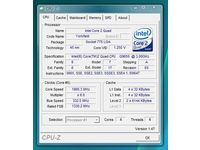

As with Alienware’s m17x, Killer Notebooks’ Odachi is no Centrino 2 prodigy. In fact, it’s not even based on a mobile platform. It instead comes with a desktop Core 2 Quad Q9650 processor running at 3 GHz. Naturally, this is going to give the Odachi a significant benefit in multi-threaded applications, since it’s the only offering in our roundup sporting four cores.
The Q9650 is one of the best-rounded chips in the Core 2 Quad family. Centering on Intel’s Yorkfield design, it’s manufactured at 45 nm, armed with 12 MB of L2 cache, and set up to run on a 1,333 MHz front side bus.
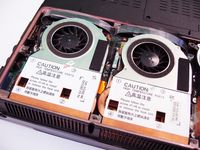
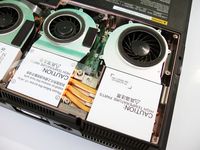
The caveat, of course, is that this is a desktop CPU with all of the power and thermal requirements that accompany such a chip. Perhaps most significant is its 95 W TDP—more than twice that of the Core 2 Extreme X9000 used in Alienware’s Area-51. Then there’s the desktop chipset needed to enable this processor: Intel’s P965 platform. We’d expect these factors to weigh in on the battery benchmarks.
Memory
With support for DDR2 at up to 800 MHz, the P965 isn’t a bad chipset choice for a performance notebook—it’s just not the most current. Nevertheless, Killer Notebooks loads the Odachi down with 4 GB of DDR2-800 running aggressive 5-5-5-18 timings in a dual-channel configuration.
Get Tom's Hardware's best news and in-depth reviews, straight to your inbox.
Again, as with the Alienware, our sample showed up recognizing all 4 GB of installed memory. However, this was because Killer Notebooks shipped the system with a 64-bit copy of Vista Ultimate (Alienware included x32 Home Premium). After clearing everything off for our 32-bit benchmark suite, the system wasn’t able to see all 4 GB. But the company sent us a detailed instruction list on getting Vista to see all installed memory if we wanted to use it. Clearly, this is an organization dedicated to a more tuned experience than what you’d get from the tier-one brands.
Graphics
Although they come from a previous generation of named graphics processors, the GeForce 8800M GTX GPUs used in Killer Notebooks’ Odachi are actually better than the 9800M GTs used in Alienware’s m17x. Again, chalk it up to poor naming on Nvidia’s part.
From an architecture standpoint, the two mobile components are similar. Both center on the G92M GPU manufactured at 65 nm. Both include 96 unified shader processors fed by 512 MB of GDDR3 memory on a 256-bit bus. Where the components differ is clock speed. The 8800M GTXs boast 560 MHz clocks, 1,400 MHz shaders, and 900 MHz memory. All three figures are faster than what you’ll get from the 9800M GTs.

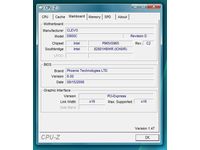
The Odachi wields two 8800M GTX boards running in SLI. Because the P965 only offers one PCI Express x16 pathway (at v. 1.1 signaling speeds), the pair is forced to share the chipset’s limited bandwidth. Again, GPU-Z reports that each card has its own x16 connection, though—likely due to the N100 bridge chip used to make SLI possible on Intel-based platforms.
Storage
Here’s where Killer Notebooks gets really aggressive. The Clevo chassis used to build the 17” Odachi notebooks can accommodate three 2.5” SATA hard drives—two in a special cage and one more under the battery. Whereas Alienware shot for capacity by using two 500 GB, 5,400 RPM Samsung drives, Killer Notebooks opts for a trio of 160GB Western Digital Scorpio Black Edition drives spinning at 7,200 RPM. Interestingly, all three are striped together in a super-quick RAID 0 array.
However, our storage goblins were out to get us again. During the course of testing, one of the Scorpios consistently threw up errors that prompted Intel’s Matrix Storage Manager to warn us a drive was failing. We pulled the culprit, rebuilt the RAID array using two drives, and continued on our way.
Fortunately, Killer Notebooks offers a one year global warranty on its products. In this case, an advanced replacement would have been covered. We’re still wary about RAID 0 on mobile platforms, though. SSDs truly seem like a more durable way to enable great performance on a notebook—especially these premium models.
Networking
Gigabit Ethernet is enabled through a Realtek controller and 802.11a/g/draft-n comes standard.
Chassis/LCD
Whitebook builders will recognize Killer Notebooks’ Odachi as a Clevo D9C (listed as the D900C on the company’s Website. Clevo sells that particular model with three different 17.1” LCD panel choices: WXGA (1440x900), WSXGA+ (1680x1050), or WUXGA (1920x1200). The Odachi’s graphics subsystem is, for the most part, able to drive the highest-end configuration at its native resolution, so we were happy to see our sample ship with a sharp 1920x1200 screen.
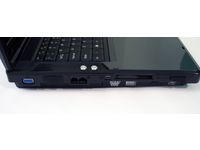
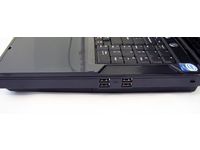
The Clevo D9C sports lots of I/O. Up front you’ll find audio connectivity—a headphone output, microphone input, digital S/PDIF output, and a line-in jack. The right side of the notebook sports four USB 2.0 ports and a Kensington lock. The left side includes a card reader, an ExpressCard bay (in which Killer Notebooks installed an 8 GB Lexar SSD), a mini FireWire 400 jack, Gigabit Ethernet, a modem jack, VGA output, and S-Video/CATV connectors. An optical bay below all of those connectors hosts a dual-layer DVD burner, through Killer Notebooks also offers a Blu-ray upgrade option. Spin the notebook around and you’ll find a DVI output, an AC power hookup, and a curiously-located video input.
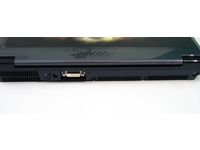
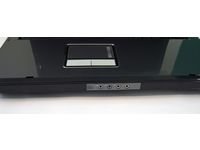
Killer Notebooks’ Odachi sports a 12-cell, 6,600 mAh battery, just like Alienware’s offering does. Not surprisingly, it also doesn’t last very long away from a power outlet. Must have something to do with that 95 W CPU.
Current page: Killer Notebooks’ 17.1” Odachi: Hardware
Prev Page ASUS G71 Republic Of Gamers: Look And Feel Next Page Killer Notebooks’ Odachi: Look and Feel-
kitsilencer From a money point of view, it's never going to make sense buying a gaming laptop. Scaled down performance and inability to upgrade are issues.Reply
But it sure as hell feels good having one ^___^ -
neiroatopelcc http://www.tomshardware.com/reviews/gaming-notebook-roundup,2023-6.htmlReply
"shipped the system with a 64-bit copy of Vista Ultimate (Alienware included x32 Home Premium)." -
ap90033 4 Grand? Are you guys nuts? I would say that right there would rule out about 90% of us normal gmaers..Reply
Besides the gaming scores looked weak imo..
I personally thought it was a better idea to go get a Gateway P7811FX with a single Geforce 9800GTS. It plays Call of Duty at 1920x1200 max settings around 50FPS. AND it cost me ONLY $1249 (Plus Best Buy let me pick any game I wanted for FREE!) -
agree with kitsilencer, gaming laptop is never practical.Reply
even with a beast graphics card, you'd be pretty hard to get more than 2 hours of shitty performance.
get a gaming desktop and perhaps an EEE or iPhone for travelling. my iPhone has 20+ games and enough media (don't forget TV connector for watching films in hotels) to keep me busy for more than one week away from my gaming rig. -
ap90033 Not true my "Gmaing Laptop" is great at LAN Parties and I play it for 6-8 Hours straight there...Reply
I think maybe you had a bad experience with a laptop that claimed to be a "gaming" laptop. I bought one before like that and it have an 8600M Geforce and it Sucked bad... If you get a good laptop with say a 9800gts or so you would be suprised... -
GlItCh017 ap900334 Grand? Are you guys nuts? I would say that right there would rule out about 90% of us normal gmaers..99.90%Reply -
ap90033 PS gaming laptops hold value much better than desktops. I had one I paid 1250 for, had it for a year, then sold it for $1100 and bought the newer "upgraded" model that just came out for $1250. I got an Upgraded CPU (From Core 2 1.67 GHZ to Core 2 Centrino 2 2.26 GHZ), Memory (from 3 Gigs DDR2 667MHZ to 4 Gigs DDR3 1066MHZ), Hard Drive (faster), Video Card (from 8800gts to 9800GTS), Screen (from 1440x800 to 1920x1200) and OS (From 32 bit to 64 bit). Not bad upgrade for $150 or so!Reply
